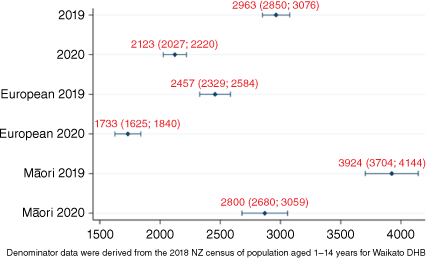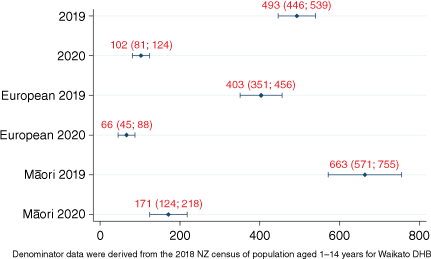Changing patterns of otitis media in the Waikato region during the COVID-19 pandemic
Andre Becker 1 , Ha Nguyen 2 * , Michael Becker 3 , Andrew Wood
2 * , Michael Becker 3 , Andrew Wood  4 5 , Ross Lawrenson 2 4
4 5 , Ross Lawrenson 2 4
1 Otago Medical School, The University of Otago, Wellington, New Zealand.
2 Medical Research Centre, School of Health, University of Waikato, Private Bag 3105, Hamilton 3240, New Zealand.
3 Ōtorohanga Medical, 13 Kakamutu Road, Ōtorohanga, New Zealand.
4 Te Whatu Ora, Health New Zealand (Waikato).
5 Department of Surgery, FMHS, University of Auckland, New Zealand.
Journal of Primary Health Care 15(3) 224-229 https://doi.org/10.1071/HC23026
Published: 8 June 2023
Abstract
Acute otitis media (AOM) is a common condition of children encountered in general practice. A proportion of children develop otitis media with effusion (OME), which may require tympanostomy and ventilation tube insertion.
The aim of the study was to compare the incidence of AOM in Māori and New Zealand (NZ) European children in general practice and the referral practices to secondary care for tympanostomy and ventilation tube insertion.
The study was conducted in two parts: (1) an analysis of the incidence of AOM and OME in a rural Waikato general practice (Ōtorohanga) with a high Māori population over a 2-year period; and (2) an analysis of all referrals to the otorhinolaryngology (ORL) department at Waikato District Health Board and tympanostomy and ventilation tube insertion by this service over the same period.
The incidence of AOM was similar in Māori compared with NZ European children. The incidence declined significantly between 2019 and 2020 and 50% of children with AOM were treated with antibiotics. Referral rates to the ORL department were greater for Māori compared with NZ European children as were tympanostomy and ventilation tube insertion rates.
Although AOM is common, OME was rarely diagnosed. The clinical guidelines regarding antibiotic use for common conditions are not being readily adopted and further research is needed into this matter. The COVID-19 pandemic had a substantial effect on demand both in general practice and in the hospital sector. This may have been due to a reduction in the incidence of AOM or due to system changes caused by the pandemic.
Keywords: antibiotics, COVID-19 pandemic, general practice, grommet surgery, incidence, Māori, otitis media with effusion, tympanostomy.
| WHAT GAP THIS FILLS |
| What is already known: AOM is a common condition seen in young children in general practice and often treated with antibiotics. A proportion of children will develop OME and require tympanostomy and ventilation tube insertion. |
| What this study adds: This study provides an estimate of the incidence of both AOM and tympanostomy and ventilation tube insertion in Māori and NZ European children. Although the incidence of AOM was similar in Māori compared with NZ European children, tympanostomy and ventilation tube insertion rates were greater for Māori children. The COVID-19 pandemic was associated with a reduced incidence of AOM, reduced referrals to the ORL department and a reduction in tympanostomy and ventilation tube insertion. |
Introduction
Acute otitis media (AOM) is a common condition of children encountered in general practice, with one-quarter of children aged <5 years reported as presenting to general practice with at least one episode in a year.1 The recommended treatment is the provision of symptomatic relief with paracetamol and consideration of antibiotics.2 Antibiotics in very young children may provide some additional relief and prevent persistent infection,3 but guidelines suggest they are of limited use in older children. The middle ear can also commonly be affected by effusion without acute inflammation (otitis media with effusion or OME/‘glue ear’), which can lead to chronic hearing loss, developmental delay of speech and learning difficulties. Management of OME is a common problem facing New Zealand general practitioners. In an Auckland-based cohort, 4% of children with AOM developed recurrent AOM meriting consideration for tympanostomy and ventilation tube insertion.1 OME is more common in Māori and Pasifika children,4,5 with a reported rate of 25% of Pasifika children aged 2 years having OME.6 Despite OME being skewed towards Māori and Pacific children, they reportedly have lower rates of elective admissions for tympanostomy and ventilation tube insertion surgery.7 Although some children will benefit from tympanostomy and ventilation tube insertion to ventilate the middle ear and restore hearing, most children with OME do not require surgical intervention.8 The most recent American Academy of Otolaryngology guidelines recommend it only as an option when OME has been present for ≥3 months or where three episodes of AOM, referred to as recurrent AOM, have occurred over a 6- month period.9 Tympanostomy and ventilation tube insertion has been shown to improve the child’s hearing, but the benefits are relatively short lived.8 Consequently, the threshold for treatment in the public sector is high. Our hypothesis was that the inverse care law applies in our population where the greatest prevalence of AOM/OME is in those children from disadvantaged backgrounds, but that the greatest access to treatment was in the least deprived.
This study was conducted in the former Waikato District Health Board (DHB) catchment, which has a population of 430 000 and consisted of 23% Māori ethnicity. Ōtorohanga is a rural general practice providing care to a small rural town and patients from the surrounding community. It is staffed by five general practitioners, five nurses and support staff. Referrals can be made to hospital services either through the community ear nurses for assessment or directly to the Waikato DHB. The otorhinolaryngology (ORL) department at Waikato DHB provides specialist services to children with middle ear disease.
The aim of the study was to compare the incidence of AOM in Māori and NZ European children in general practice and the referral practices to secondary care for tympanostomy and ventilation tube insertion.
Methods
The study was conducted in two parts:
An analysis of the incidence of AOM and OME in a rural Waikato general practice (Ōtorohanga) with a high Māori population over a 2-year period.
An analysis of all referrals to the ORL department at Waikato DHB and tympanostomy and ventilation tube insertion by this service over the same period.
The retrospective study was carried out covering the 2-year period over 2019 and 2020. The coronavirus disease 2019 (COVID-19) pandemic hit New Zealand early in 2020, forcing a lockdown for many weeks and the temporary introduction of virtual consultations to general practice.
Ōtorohanga analysis
A query of the Ōtorohanga Medical Centre Medtech23 database was performed, searching for patients between the ages of 1 and 14 years inclusive, in the 2-year study period, with a primary ethnicity of either NZ European or Māori. NZ European patients with a secondary ethnicity of Māori were considered to be Māori (13 out of 1128 patients). The study population consisted of children registered with Ōtorohanga Medical Centre in the period January 2019 to December 2021. Patients with a status of ‘Visitor’ were excluded from the analysis. Patients’ daily records were manually reviewed for mention of inflammation of the tympanic membrane (AOM) and fluid behind the tympanic membrane (OME) between the dates of 1 January 2019 and 31 December 2020 in accordance with accepted diagnostic criteria.2 Signs of inflammation of the tympanic membrane listed in patient notes with evidence of otitis externa were not recorded as AOM. Patients’ daily record, the Inbox which contains hospital letters, and the Outbox which contains all referrals were reviewed for referral to ORL specialists or audiometry, as well as for evidence of surgical intervention in the form of tympanostomy and ventilation tube insertion.
Waikato Hospital analysis
Data from the Waikato Hospital were downloaded, assessing all referrals to the ORL department for children aged 1–14 years who were resident in the Waikato DHB for 2019 and 2020. Data were stratified by gender, ethnicity and reason for referral. Referral rates were calculated based on the age-specific populations for Māori and NZ European children from the estimated census records held by the Waikato DHB.
These referrals were then linked to treatment codes for ‘Grommet insertion’ or ‘Tympanostomy and ventilation tube insertion’ and population-based rates of tympanostomy and ventilation tube insertion were calculated for Māori and NZ European children based again on census data.
Ethical approval was granted by the University of Waikato Human Research Ethics Committee (Health) (2021#76: ‘What are the unmet needs in Waikato children with otitis media?’).
Results
The full dataset of children aged between 1–14 years inclusive registered at the Ōtorohanga medical centre at the time of this study contained 513 European/Pakeha-NZ patients in 2019 (509 in 2020) and 572 Māori-NZ patients in 2019 (580 in 2020). The incidence of a first occurrence of AOM in children was 15 per 100 in 2019, but only 7 per 100 in 2020. The greatest incidence was in children aged <5 years. The incidence in Māori was similar to that for NZ Europeans, and in both groups of children, the incidence fell to a similar extent in 2020 (Fig. 1). The presence of OME evidence revealed that only 3% of children were diagnosed with effusion in 2019, whereas in 2020, this figure was 2%. In 2019, there were eight children referred to the ORL department for consideration of tympanostomy and ventilation tube insertion, and in 2020, there were seven referrals (Fig. 2). The average age of children referred for tympanostomy and ventilation tube insertion was 3.9 years in NZ European compared to age 4.7 years for Māori. Just under 50% of cases presenting to the Ōtorohanga Medical Centre were prescribed an antibiotic (Fig. 3). This was independent of age and did not materially change in 2019 (44.3%) compared to 2020 (47.9%).
Incidence rate (per 100) of AOM in Māori and NZ European children registered with Otorohanga Medical Centre in 2019–2020.
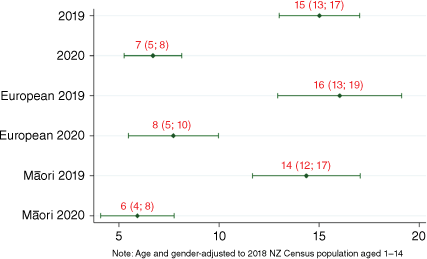
Age-specific incidence of AOM in children aged 1–14 years seen in the Otorohanga Medical Centre in 2019–2020.
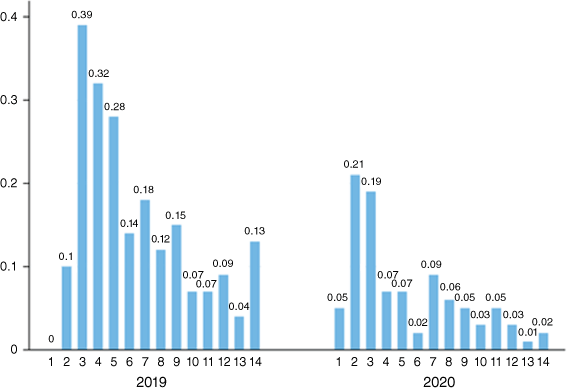
Average percentage of antibiotic prescriptions for children with TM inflammation and effusion by age in 2019 and 2020.
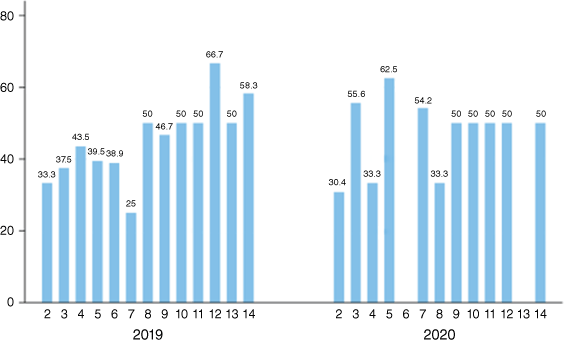
Between 2019 and 2020, there was a 28% reduction in the rate of referrals to the ORL department at Waikato DHB, from 2963 to 2123 per 100 000. It can be seen from Fig. 4 that the referral rate for Māori children was 3924 per 100 000 in 2019, whereas for NZ European children, it was 2457 per 100 000. Referral rates fell in 2020. Māori were still more likely to be referred than NZ European children. At the same time, the rate of tympanostomy and ventilation tube insertion was reduced by 79% from 493 per 100 000 in 2019 to 102 per 100 000 in 2020. However, tympanostomy and ventilation tube insertion rates in both years remained substantially higher in Māori children who had been referred compared with NZ European children (Fig. 5).
Discussion
We showed that the incidence of AOM in this rural New Zealand general practice in children aged 1–14 years was 15% in 2019. This compares with the incidence of 27.3% in children aged <5 years found in another NZ study in 2012.1 The comparator study reviewed children aged <5 years from 63 primary care facilities in NZ, with 33.2% identified as Māori. Our study included children aged 1–14 years from a rural Waikato general practice (Ōtorohanga) with a high Māori population (53%). Our study also showed a higher incidence of AOM in younger children. There was a substantial drop in the diagnosis of AOM in 2020. This is consistent with the finding that consultations involving children decreased during the period of COVID-19 lockdowns.10 The lower incidence may also be due to changes in the diagnostic rates due to the use of virtual consultations, where there was no visualisation of the tympanic membrane. Equally, noting the role of respiratory viruses in middle ear disease,11 this may reflect a true reduction in the rates of middle ear disease owing to the effect of COVID-19 lockdowns on respiratory virus infections in the community.12–15 In both years, the incidence of AOM in Māori children was similar to that seen in NZ European children, again similar to the findings of Gribben et al.1 There may be differences in consultation rates for Māori resulting in under-diagnosis, but in general, there was no evidence from this study of increased need in Māori children for the treatment of AOM. We had insufficient numbers to demonstrate a difference in consultation rates for OME between Māori and NZ European children. The antibiotic prescription rate for AOM in this general practice was close to 50%, which was higher than expected given that the guidelines suggest the use of symptomatic treatment only. However, it is similar to what has been reported by the Health Quality and Safety Commission, who noted that of people who visited their general practitioner (GP) in a year, around half were dispensed at least one systemic antibiotic, and that the highest rate of antibiotic dispensing was in children aged 0–4 year, with 63% dispensed in 2018, followed by 57% for children aged 5–9 years.16 This finding suggests that evidence-based guidelines do not always take into account the pressure on practices where there is often demand for antibiotics.17 This prescribing rate may also be increased in the presence of telemedicine, although we did not find a significant difference between 2019 and 2020.
Although we noted similar rates of AOM in Māori and NZ European children, our examination of referrals to Waikato DHB showed Māori children were almost twice as likely to be referred as NZ European children. Although the referral rate fell between 2019 and 2020, the higher referral rate for Māori children remained. This is in contrast to previous findings from earlier this century where Māori, particularly those aged <5 years, were less likely to be referred7 and less likely to receive a tympanostomy and ventilation tube insertion. Although only a proportion of our patients referred would be for OME, we also noted that Māori children were more likely to receive a tympanostomy and ventilation tube insertion than NZ European children. This may be because of an increased incidence of OME, preferential selection of Māori children for treatment in the public sector or maybe that a higher proportion of NZ European children are treated in the private sector. However, it does seem that the inequities noted by McCallum et al.7 are being addressed, at least in this region. The tympanostomy and ventilation tube insertion is not a common procedure, with only five to eight children per 1000 per year receiving a tympanostomy and ventilation tube insertion operation during the study period. The reduction in both referrals and tympanostomy and ventilation tube insertion between 2019 and 2020 was quite significant. We noted similar reductions in both Māori and NZ European children. However, for some children, there is no doubt that a tympanostomy and ventilation tube insertion is warranted and can help with improving hearing and behaviours in selected children.
The strengths of these two studies are that they are population-based studies examining the relationship between general practice and specialist care in a region with a high Māori population. A weakness is that we only had data available from a single general practice, which may not be representative of practices in the region as a whole. Also, as this is an observational study of GP records, which are based on otoscopy, there may be some misdiagnoses (eg of cases of otitis externa being classified wrongly as AOM or under-diagnosis of OME when typanometry is not available to help diagnosis in otherwise symptomless children). However, the finding that both the incidence of AOM in 2019 and the prescribing of antibiotics are in line with the findings from other studies suggest that our general practice data do have some validity. The novel finding is the marked reduction in both general practice and the hospital sector in 2020 in both the identification of AOM and in the referral and treatment of OME. The COVID-19 lockdown, as reported anecdotally, did indeed reduce the demand for treatment of acute infectious conditions, and it appears that this has helped reduce the burden of chronic conditions such as OME. This may have been due to a decrease in the incidence of AOM because of a reduction in upper respiratory infections. Or it may be that some of the reduction is due to changes in how the healthcare system has operated during the COVID-19 pandemic. As noted above, many consultations became virtual, so AOM was less likely to be diagnosed. It may also be true that the requirement of practices for patients to test for COVID-19 or to have to wait in a different area to be seen may have been a barrier to visiting the practice. Or the reduction in demand may be a combination of both.
Conclusion
Although AOM is commonly reported, OME was rarely diagnosed, but access to tympanostomy and ventilation tube insertion surgery is still needed by a low number of children. The incidence of AOM in Māori children is similar to that of NZ European children, but Māori children were more likely to be referred to hospital for an ORL condition and were more likely to be treated for OME, indicating that in the Waikato region, the previously reported inequities for Māori in the public system are not found. The COVID-19 pandemic had a substantial effect on demand both in general practice and the hospital sector. Ongoing work is needed to understand why clinical guidelines that do not recommend antibiotic use for common conditions are not being readily adopted.
References
1 Gribben B, Salkeld L, Hoare S, et al. The incidence of acute otitis media in New Zealand children under five years of age in the primary care setting. J Prim Health Care 2012; 4(3): 205-12.
| Crossref | Google Scholar |
2 BPACNZ. Otitis media: a common childhood illness. 2022. Available at https://bpac.org.nz/2022/otitis-media.aspx
3 Hoberman A, Paradise JL, Rockette HE, et al. Treatment of acute otitis media in children under 2 years of age. N Engl J Med 2011; 364(2): 105-15.
| Crossref | Google Scholar |
4 Johnston J, McLaren H, Mahadevan M, et al. Surgical treatment of otitis media with effusion in Maori children. ANZ J Surg 2018; 88(11): 1141-4.
| Crossref | Google Scholar |
5 Dickinson LJ, Nimmo M, Morton RP, et al. ‘Asymptomatic’ South Auckland preschool children have significant hearing loss and middle ear disease. Int J Pediatr Otorhinolaryngol 2018; 114: 106-10.
| Crossref | Google Scholar |
6 Paterson JE, Carter S, Wallace J, et al. Pacific Islands families study: the prevalence of chronic middle ear disease in 2-year-old Pacific children living in New Zealand. Int J Pediatr Otorhinolaryngol 2006; 70(10): 1771-8.
| Crossref | Google Scholar |
7 McCallum J, Craig L, Whittaker I, et al. Ethnic differences in acute hospitalisations for otitis media and elective hospitalisations for ventilation tubes in New Zealand children aged 0–14 years. N Z Med J 2015; 128(1416): 10-20.
| Google Scholar |
8 Browning GG, Rovers MM, Williamson I, et al. Grommets (ventilation tubes) for hearing loss associated with otitis media with effusion in children. Cochrane Database Syst Rev [10] 2010; CD001801.
| Crossref | Google Scholar |
9 Rosenfeld RM, Schwartz SR, Pynnonen MA, et al. Clinical practice guideline: tympanostomy tubes in children. Otolaryngol Head Neck Surg 2013; 149(1_suppl): S1-35.
| Crossref | Google Scholar |
10 Foley KA, Maile EJ, Bottle A, et al. Impact of COVID-19 on primary care contacts with children and young people in England: longitudinal trends study 2015–2020. Br J Gen Pract 2022; 72(720): e464-71.
| Crossref | Google Scholar |
11 Heikkinen T, Chonmaitree T. Importance of respiratory viruses in acute otitis media. Clin Microbiol Rev 2003; 16(2): 230-41.
| Crossref | Google Scholar |
12 Trenholme A, Webb R, Lawrence S, et al. COVID-19 and infant hospitalizations for seasonal respiratory virus infections, New Zealand, 2020. Emerg Infect Dis 2021; 27(2): 641-3.
| Crossref | Google Scholar |
13 Kuitunen I, Artama M, Mäkelä L, et al. Effect of social distancing due to the COVID-19 pandemic on the incidence of viral respiratory tract infections in children in Finland during early 2020. Pediatr Infect Dis J 2020; 39(12): e423-7.
| Crossref | Google Scholar |
14 Aldè M, Di Berardino F, Marchisio P, et al. Effects of COVID-19 lockdown on otitis media with effusion in children: future therapeutic implications. Otolaryngol Head Neck Surg 2021; 165(5): 710-5.
| Crossref | Google Scholar |
15 Kaur R, Schulz S, Fuji N, et al. COVID-19 pandemic impact on respiratory infectious diseases in primary care practice in children. Front Pediatr 2021; 9: 722483.
| Crossref | Google Scholar |
16 Health Quality and Safety Commission New Zealand. Community use of antibiotics. 2021. Available at https://www.hqsc.govt.nz/our-data/atlas-of-healthcare-variation/community-use-of-antibiotics/
17 Ryan J, Giles M. Management of acute otitis media by New Zealand general practitioners. N Z Med J 2002; 115(1148): 67-9.
| Google Scholar |


